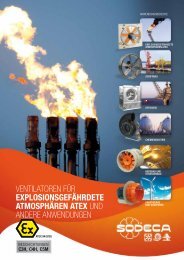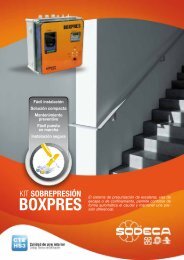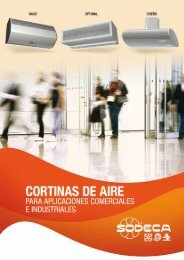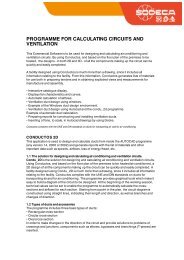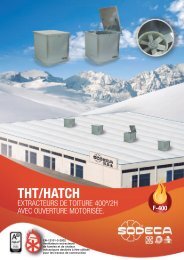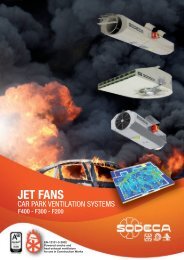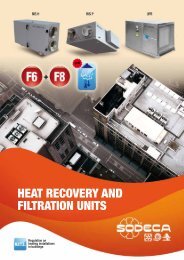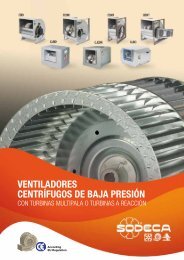FAN AIRFLOW AND PRESSURE 1.1. Airflow Q A fanʼs ... - Sodeca
FAN AIRFLOW AND PRESSURE 1.1. Airflow Q A fanʼs ... - Sodeca
FAN AIRFLOW AND PRESSURE 1.1. Airflow Q A fanʼs ... - Sodeca
- No tags were found...
Create successful ePaper yourself
Turn your PDF publications into a flip-book with our unique Google optimized e-Paper software.
<strong>FAN</strong> <strong>AIRFLOW</strong> <strong>AND</strong> <strong>PRESSURE</strong><strong>1.1.</strong> <strong>Airflow</strong> QA fanʼs airflow (Q) is the amount of air that it can displace per unit of time.It is expressed in m3/h (1.7 m3/h = 1 CFM).1.2. Dynamic pressure (Pd)This is the force per unit of surface area produced by the movement of the air and it is exerted in the same direction asthe direction of the airflow. This pressure is always positive.1.3. Static Pressure (Pe)This is the value of the force exerted by air on the duct walls, perpendicular to them. This pressure is positive when it isgreater than atmospheric pressure. If the duct walls were elastic, we would see them dilate and bulge. (Overpressure).When it was negative, i.e. less than the atmospheric pressure, the walls would contract (underpressure).1.4. Total pressure (Pt)This is the sum of the static and dynamic pressure.Pt = Pe + PdThe unit of pressure used is mmH2O (mm of column of water) and it is equivalent to:1mmH2O = 9.80665 Pa = 1mm.Wg1 Pa (Pascal) = 1 N/m2<strong>FAN</strong> TESTINGFan testing aims to determine the airflow and pressure they provide, as well as all their electrical data and sound levels,in order to establish their characteristic curves.2.1 <strong>Airflow</strong>/pressure testing<strong>Airflow</strong> and pressure testing on SODECA fans is carried out at our fluid mechanics laboratory, in accordance withANSI/AMCA ST<strong>AND</strong>ARD 210-85 and UNE 100-212-90. Fig. 1 shows the schematic of the ANSI/AMCA CHAMBERfacility, with nozzles on the output and a variable system for the removal of air, used for axial fan measurement andtesting. For testing centrifugal fans, regulation 7 of the above ANSI/AMCA standards is used.2.2 Noise level testingDue to the displacement of air and the movement of the impeller or turbine, the fan causes a certain level of noise,which is measured at our laboratory in accordance with standards ISO-3744 and ISO-3745. The values are determinedaccording to free field measurements of pressure and sound levels, given in dB (A).GRAPHICAL REPRESENTATION OF TESTSA fanʼs characteristics curve is a graphical representation bringing together, on coordinate axes, all the values resultingfrom the tests. This curve will represent all the fanʼs possible working points. For any characteristics curve in thiscatalogue, we can see how the airflow (Q), plotted on the x-axis, drops as the static pressure (Pe) increases on the y-axis, and the airflow is at its maximum when the static pressure is 0, which is called free delivery. Thus we can see howthe fan's curve gives us graphical information about the airflows that it can produce depending on the pressure that werequire. Data given in our characteristics curves correspond to:- Temperature - 20ºC- Air density - 1.2046 kg/m3.- Atmospheric pressure - 760 mm Hg.<strong>FAN</strong> LAWS
The operation of a fan is governed by three basic parameters: specific weight of the air it impels d, angular (rotational)speed n and impeller diameter D. When these change, so do the characteristics of the fan. We will now consider each ofthe cases of changing one of the parameters while the other two remain constant:4.1. Changing d, while n and D remain constant.The characteristics of the fan are expressed for a specific weight d = 1.2 Kg/m3. Changes to this result in directlyproportional changes to the pressures and to the power absorbed by the impeller. The airflow rate will remainunchanged.If d' is the new specific weight, this gives:4.2. Changing n, while d and D remain constant.Changing the impeller's rotational speed causes the characteristics to change as follows:n' is the value of the new speed.4.3. Changing D, while d and n remain constant. This relationship is only valid for fans which are geometrically similar.A new value, D' will give:<strong>FAN</strong> COUPLING5.1. Fans coupled in parallelNotes: 1. Calculation of the curve for coupled fans. The airflow of the combination (Q) is the sum of the individualairflows of each fan at points of equal pressure.2. When calculating the system curve, the losses in the individual connections to each fan must be included. 3. Thesystem curve must cut the curve of the combination, otherwise the fan providing higher pressure, working alone, wouldgive a higher airflow.When the curve of the system does not cut the curve of the combination, or cut the prolongation of this curve before fanB, fan B will give a higher airflow than the coupling of A and B in parallel.5.2. Fans coupled in series
Notes: 1. Calculation of the curve for coupled fans. The total pressure of the combination is the sum of the individualpressures, with the same airflow less the loss of head (or pressure) in the connection between fans. 2. The airflowthrough both fans will be the same because air is considered to be incompressible. 3. The system curve must cut thecurve for the combination, otherwise the larger fan would give more airflow, working alone, than the combination of thetwo fans.



